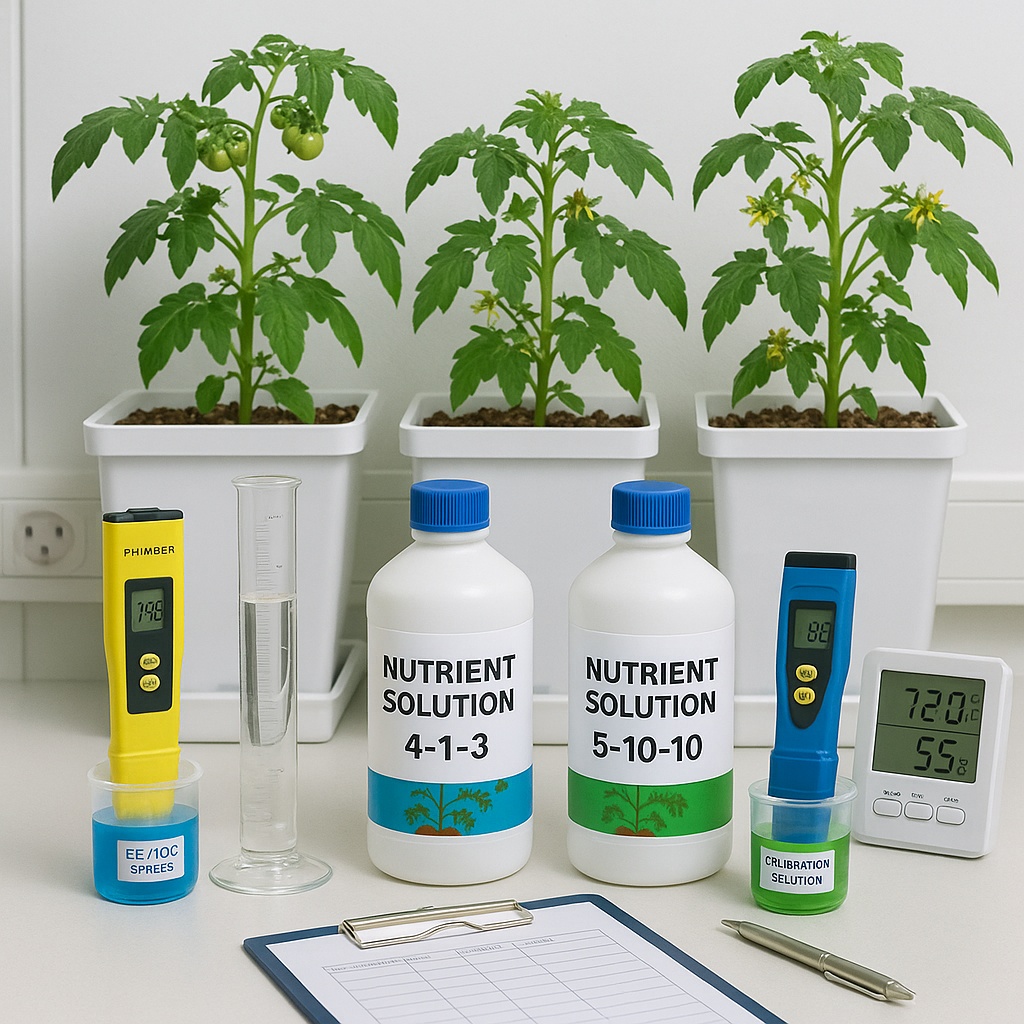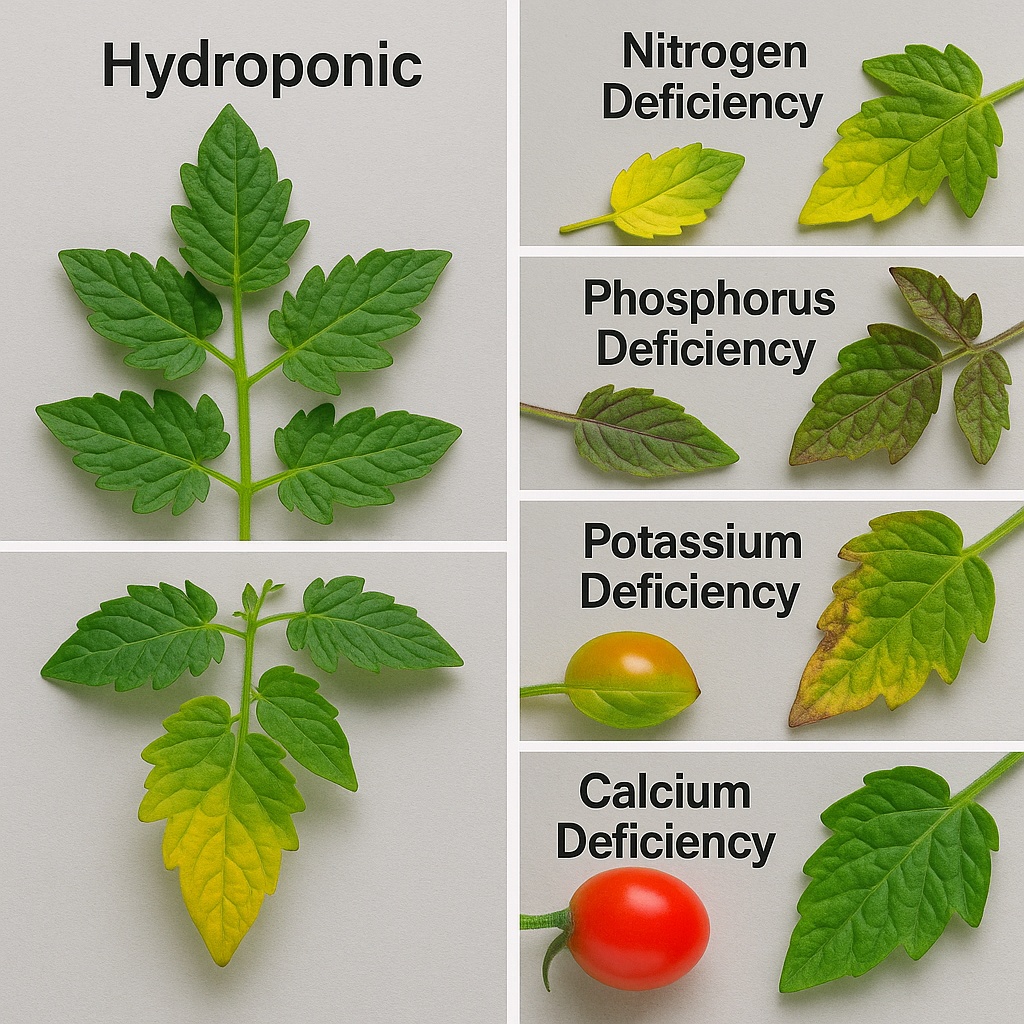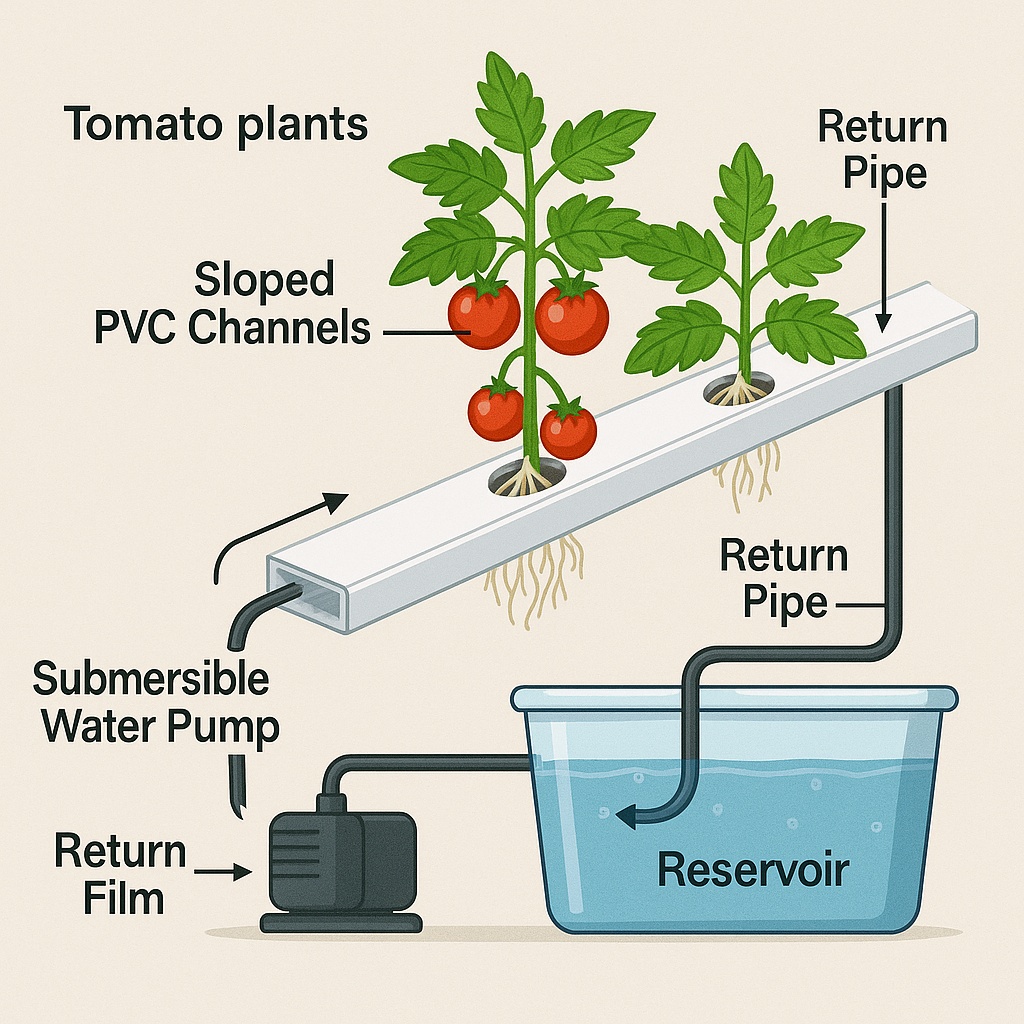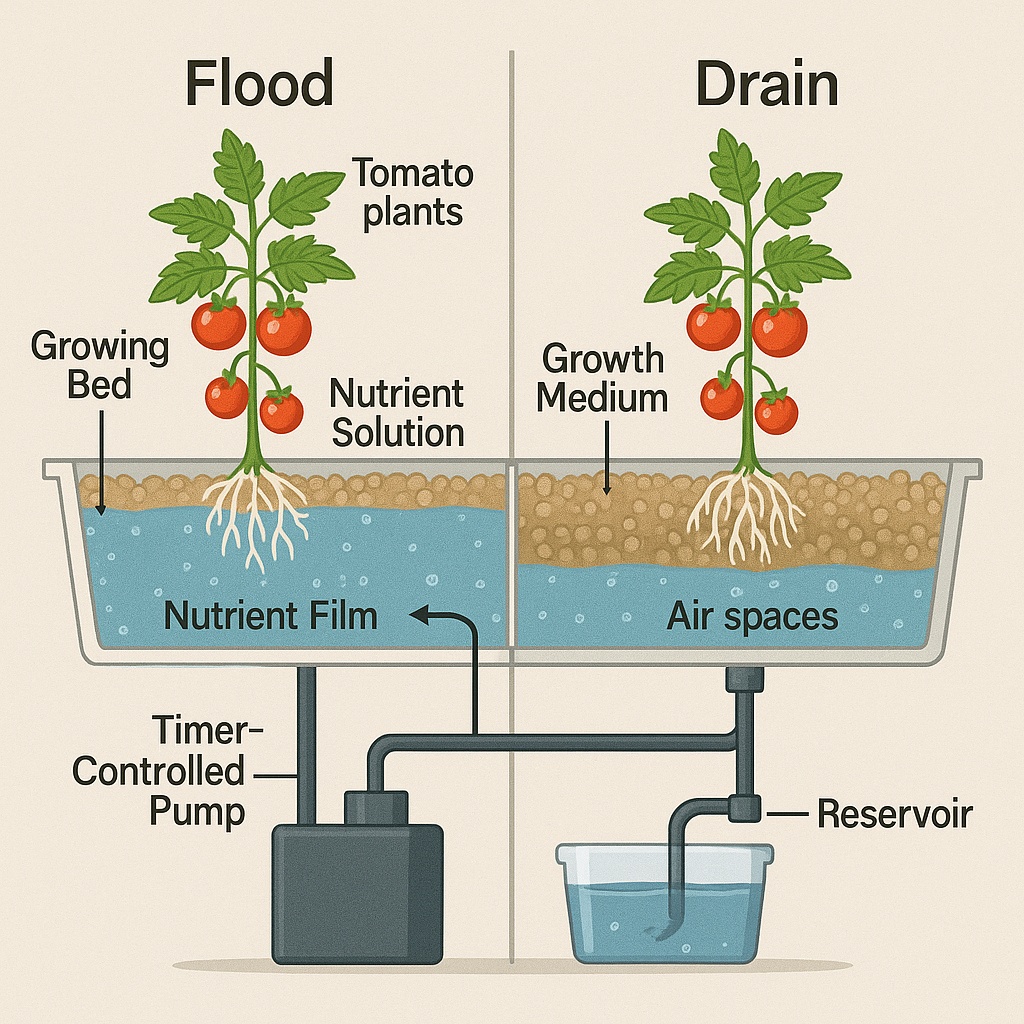Proper nutrient management for hydroponic tomatoes determines the difference between mediocre harvests and exceptional yields. Unlike soil growing, hydroponic tomatoes depend entirely on you to provide precise nutrition at each growth stage.
Building on the system setup covered in Part 2 of our series, this comprehensive guide provides a proven 7-stage feeding schedule and expert nutrient management strategies for hydroponic tomatoes.
Understanding Hydroponic Tomatoes Nutrition Needs
Nutrient management for hydroponic tomatoes requires understanding how plants absorb and utilize different nutrients throughout their lifecycle. Research from the University of California demonstrates that proper nutrient timing can increase hydroponic tomatoes yields by 35-50% compared to generic feeding schedules [1].
Hydroponic tomatoes require 16 essential nutrients divided into three categories:
- Macronutrients: Nitrogen (N), Phosphorus (P), Potassium (K)
- Secondary nutrients: Calcium (Ca), Magnesium (Mg), Sulfur (S)
- Micronutrients: Iron (Fe), Manganese (Mn), Zinc (Zn), Boron (B), and others
The key to successful nutrient management for hydroponic tomatoes lies in adjusting these ratios as plants progress through distinct growth phases.

Essential Equipment for Nutrient Management
Before diving into feeding schedules, ensure you have proper monitoring equipment for nutrient management for hydroponic tomatoes:
pH and EC Monitoring
- Digital pH meter: Accurate to 0.1 pH units with automatic temperature compensation
- EC/TDS meter: Measures nutrient concentration in parts per million (ppm)
- Calibration solutions: pH 4.0, 7.0, and 10.0 buffers plus EC standards
- pH adjustment: Phosphoric acid (pH Down) and potassium hydroxide (pH Up)
Nutrient Solution Preparation
- Measuring containers: Graduated cylinders or syringes for accuracy
- Mixing reservoir: Clean containers for solution preparation
- Stirring equipment: For thorough nutrient mixing
- Storage containers: Light-proof bottles for concentrated nutrients
For detailed information about pH monitoring and adjustment techniques, our comprehensive guide covers the fundamentals.
The 7-Stage Feeding Schedule for Hydroponic Tomatoes
Professional nutrient management for hydroponic tomatoes follows distinct growth stages, each requiring specific nutrition ratios and concentrations.
Stage 1: Seedling (Weeks 1-2)
Objective: Establish healthy root development and initial leaf growth
Nutrient Ratios (N-P-K): 1-1-2 ratio EC Level: 0.8-1.2 (560-840 ppm) pH Range: 5.8-6.2 Feeding Frequency: 2-3 times daily, light concentration
Key nutrients for this stage:
- Low nitrogen to prevent burning tender roots
- Balanced phosphorus for root development
- Adequate potassium for cell development
- Calcium for strong cell walls
Stage 2: Early Vegetative (Weeks 3-4)
Objective: Rapid leaf and stem development
Nutrient Ratios (N-P-K): 2-1-3 ratio EC Level: 1.2-1.6 (840-1120 ppm)
pH Range: 5.8-6.0 Feeding Frequency: 3-4 times daily
Increase nitrogen levels to support vigorous leaf growth while maintaining strong root development. This stage sets the foundation for future fruit production.

Stage 3: Late Vegetative (Weeks 5-6)
Objective: Maximum vegetative growth before flowering
Nutrient Ratios (N-P-K): 3-1-4 ratio EC Level: 1.6-2.0 (1120-1400 ppm) pH Range: 5.8-6.0
Feeding Frequency: 4-5 times daily
Peak nitrogen levels support rapid growth while increasing potassium prepares plants for flowering. Monitor for first flower clusters appearing.
Stage 4: Early Flowering (Weeks 7-8)
Objective: Transition from vegetative growth to flower production
Nutrient Ratios (N-P-K): 2-2-4 ratio EC Level: 1.8-2.2 (1260-1540 ppm) pH Range: 5.8-6.2 Feeding Frequency: 5-6 times daily
Reduce nitrogen while increasing phosphorus to support flower development. First flower clusters should be visible and developing.
Stage 5: Full Flowering (Weeks 9-10)
Objective: Maximum flower production and early fruit set
Nutrient Ratios (N-P-K): 1-2-5 ratio
EC Level: 2.0-2.4 (1400-1680 ppm) pH Range: 6.0-6.4 Feeding Frequency: 6-7 times daily
Lower nitrogen prevents excessive vegetative growth while high phosphorus and potassium support flower development and fruit set. Calcium becomes critical for preventing blossom end rot.
Stage 6: Early Fruiting (Weeks 11-14)
Objective: Fruit development and continued flowering
Nutrient Ratios (N-P-K): 1-1-6 ratio EC Level: 2.2-2.6 (1540-1820 ppm)
pH Range: 6.0-6.4 Feeding Frequency: 7-8 times daily
High potassium supports fruit development while maintaining adequate phosphorus for continued flowering. Monitor fruit size and development closely.

Stage 7: Heavy Production (Weeks 15+)
Objective: Maximum fruit production and quality
Nutrient Ratios (N-P-K): 1-1-7 ratio EC Level: 2.4-2.8 (1680-1960 ppm) pH Range: 6.0-6.5
Feeding Frequency: 8-10 times daily
Peak potassium levels support heavy fruit loads while balanced nutrition maintains plant health for extended production periods.
Critical Secondary Nutrients
Beyond NPK ratios, nutrient management for hydroponic tomatoes requires careful attention to secondary nutrients:
Calcium Management
Importance: Prevents blossom end rot and maintains cell structure Optimal levels: 150-200 ppm throughout all stages Sources: Calcium nitrate, calcium chloride Signs of deficiency: Brown spots on fruit bottoms, leaf tip burn
Magnesium Requirements
Function: Chlorophyll production and enzyme activation Optimal levels: 50-75 ppm Sources: Magnesium sulfate (Epsom salt) Deficiency symptoms: Yellowing between leaf veins
Sulfur Considerations
Role: Protein synthesis and oil production
Optimal levels: 60-100 ppm Sources: Magnesium sulfate, potassium sulfate Deficiency signs: Overall yellowing, reduced growth
For comprehensive guidance on system selection and setup, Part 2 covers all major growing systems.
Micronutrient Management
Micronutrients, while needed in small quantities, are essential for optimal nutrient management for hydroponic tomatoes:
Iron (Fe)
Function: Chlorophyll synthesis and electron transport Optimal levels: 2-3 ppm Best form: Chelated iron (EDTA or DTPA) Deficiency symptoms: Yellow leaves with green veins
Boron (B)
Role: Cell wall formation and calcium uptake Optimal levels: 0.3-0.5 ppm Critical for: Fruit set and development Deficiency signs: Poor fruit set, corky spots on fruit

Daily Monitoring and Adjustments
Successful nutrient management for hydroponic tomatoes requires consistent daily monitoring:
Morning Routine (8:00 AM)
- Check pH levels: Adjust if outside target range
- Measure EC/TDS: Note any significant changes
- Observe plant health: Look for nutrient deficiency signs
- Record data: Maintain detailed logs for troubleshooting
Evening Routine (6:00 PM)
- Recheck pH: Plants affect solution pH throughout the day
- Monitor solution levels: Top off with pH-adjusted water
- Assess feeding frequency: Adjust timer settings if needed
- Plan next day: Note any required nutrient adjustments
Weekly Maintenance
- Complete solution change: Fresh nutrients every 7-14 days
- System cleaning: Remove algae and debris
- Equipment calibration: Check meter accuracy
- Nutrient stock preparation: Mix fresh concentrated solutions
Common Nutrient Problems and Solutions
Understanding common issues in nutrient management for hydroponic tomatoes helps prevent serious crop losses:
Nutrient Burn
Symptoms: Brown, crispy leaf edges Causes: Excessive EC levels or imbalanced nutrients Solutions: Reduce concentration, flush with plain water, rebalance nutrients
Nutrient Lockout
Symptoms: Multiple deficiency signs despite adequate feeding Causes: Incorrect pH, excessive salts, root damage Solutions: Check pH, flush system, reduce EC levels
Calcium Deficiency (Blossom End Rot)
Symptoms: Dark, sunken spots on fruit bottoms
Causes: Inconsistent watering, high nitrogen, pH issues Solutions: Maintain consistent moisture, reduce nitrogen, optimize pH
Magnesium Deficiency
Symptoms: Yellowing between leaf veins, starting with older leaves Causes: High potassium levels, low pH, insufficient magnesium Solutions: Add Epsom salt, adjust pH, reduce potassium temporarily
Advanced Feeding Strategies
Experienced growers can implement advanced techniques in nutrient management for hydroponic tomatoes:
Split Application Method
Divide daily nutrients into multiple smaller feedings rather than fewer large ones. This approach:
- Reduces nutrient stress on plants
- Improves uptake efficiency
- Maintains more stable solution concentrations
- Allows for fine-tuning throughout the day
Environmental Response Feeding
Adjust feeding schedules based on environmental conditions:
- High light days: Increase feeding frequency and concentration
- Cloudy periods: Reduce feeding to prevent nutrient buildup
- High temperatures: More frequent, lighter feedings
- Cool conditions: Fewer, more concentrated feedings
Frequently Asked Questions
Q: How often should I change the complete nutrient solution? A: For optimal nutrient management for hydroponic tomatoes, change the complete solution every 7-14 days, depending on plant size and environmental conditions.
Q: What causes my nutrient solution pH to drift constantly? A: pH drift is normal as plants absorb nutrients at different rates. Young plants typically raise pH, while mature plants may lower it. Daily monitoring and adjustment are essential.
Q: Can I use the same nutrient formula throughout the entire growing cycle? A: No, hydroponic tomatoes have dramatically different nutrient needs at each growth stage. Using a 7-stage feeding schedule significantly improves yields and plant health.
Q: Why do my tomatoes develop blossom end rot despite adequate calcium? A: Blossom end rot often results from inconsistent watering or pH issues preventing calcium uptake, rather than actual calcium deficiency in the solution.
Q: Should I use organic or synthetic nutrients for hydroponic tomatoes? A: Both can work, but synthetic nutrients offer more precise control and immediate availability, making them preferred for nutrient management for hydroponic tomatoes.
Preparing for Plant Training
With proper nutrition established, your hydroponic tomatoes will grow vigorously and require training and support. Part 4 of our series covers essential techniques for maximizing yields through proper plant training, pruning, and support systems.
Effective nutrient management for hydroponic tomatoes creates the foundation for healthy growth, but proper training techniques ensure you capture the maximum potential of that vigorous growth. The combination of precise nutrition and expert training methods produces the exceptional yields that make hydroponic growing so rewarding.
For troubleshooting any issues that arise during the growing process, Part 5 provides comprehensive problem-solving strategies.
References
[1] University of California Cooperative Extension. “Hydroponic Tomato Nutrition Management for Maximum Yields.” Department of Plant Sciences, 2023.
Complete Hydroponic Tomatoes Series: